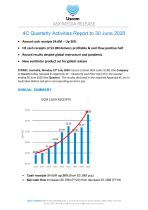
Multi-parameter monitor on casters USCOM 1A® ECGstroke volumeNIBP

Add to favorites
Compare this product
Characteristics
- Configuration
- on casters
- Measured parameter
- ECG, stroke volume, NIBP, SpO2, blood flow
- Applications
- for critical care, hemodynamic
- Technology
- Doppler
- Options and accessories
- with touchscreen
- Other characteristics
- non-invasive, high-resolution
- Screen size
12.1 in
- Battery life
2 h
- Weight
5.4 kg
(11.9 lb)
Description
USCOM 1A uses advanced Doppler hemodynamics to monitor cardiac blood flow. Stroke Volume (SV) monitoring changes the way we manage fluid, inotropes, and vaso-actives, and how we diagnose and manage sepsis, heart failure and hypertension.
Fluid remains one of the most challenging clinical interventions and inappropriate administration has dire outcomes.
Sepsis is a medical emergency characterized by altered circulation, with death caused ultimately by circulatory failure.
Heart failure is the leading cause of death worldwide and early detection allows optimal management.
Hypertension damages the heart, vessels, brain and kidneys resulting in, at best, poor quality of life, while early detection and management of underlying hemodynamic derangements is crucial to improving therapy and outcomes.
USCOM 1A accurately measures blood flow, Stroke Volume and Cardiac Output, across the aortic or pulmonary valve. Regardless of whether the patient is in sinus rhythm, atrial fibrillation, on vasopressors, on and off ventilation or experiencing active autonomic regulatory changes such as in sepsis, USCOM 1A is reliable. This distinguishes USCOM 1A from blood pressure devices which display surrogates of flow derived from blood pressure measures.
USCOM 1A is improving management and saving lives in the neonatal, pediatric, critical care, emergency, perioperative, oncological, maternal and perinatal populations. Appropriate use of the USCOM 1A reduces mortality in septic shock patients.
Over 500 publications confirm the clinical utility of the USCOM 1A and demonstrate its outstanding reliability and reproducibility and role in clinical medicine - and it’s non-invasive.
VIDEO
Catalogs
USCOM 1A
3 Pages
Uscom Q4 FY20 4C Report
10 Pages
Related Searches
- Multiparameter monitor
- Oxygen multi-parameter monitor
- SpO2 multiparameter monitor
- ECG multiparameter monitor
- Blood pressure multiparameter monitor
- NIBP multiparameter monitor
- Intensive care multiparameter monitor
- Multiparameter monitor with touchscreen
- Spirometer
- Hand-held spirometer
- Computer-based spirometer
- Spirometer with USB connection
- High-resolution multiparameter monitor
- Non-invasive multi-parameter monitor
- Hand-held spirometer
- Hemodynamic monitor
- Home use spirometer
- Cardiac output multiparameter monitor
- Spirometer with Bluetooth
- Spirometer with touchscreen
*Prices are pre-tax. They exclude delivery charges and customs duties and do not include additional charges for installation or activation options. Prices are indicative only and may vary by country, with changes to the cost of raw materials and exchange rates.







